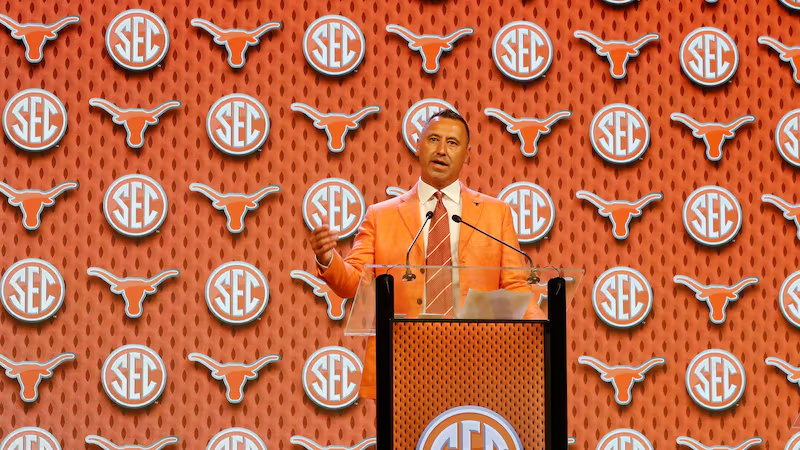The college football season came to conclusion on Monday night when Ohio State throttled Oregon in the first-ever College Football Playoff national championship game. As soon as the final gun sounded in Arlington, fans began discussing the prospects for 2015 – that’s what fans do.
Courtesy of an early bowl game, Texas fans got a head start on the crowd and have been talking about “next season” for two weeks. In order to have any legitimate discussion about 2015, fans need to take into account the biggest story lines from 2014.
A glance in the rear view mirror shows these stories will be how last season is remembered by Longhorn faithful:
Charlie Strong’s 5 Core Values
No guns. No stealing. No drugs. Be honest. Treat women with respect.
Charlie Strong’s core value got loads of publicity, especially when the Horns’ head coach started dismissing players for violating them. There was even a meeting in Austin with NFL commissioner Roger Goodell about how the core values could be implemented in the NFL.
No matter how elementary they seem, the core values became symbolic of the culture change in the Texas football program. For the first time in over a decade, a season started without Mack Brown at the helm of the Longhorns, and the core values took on the role of cleaning Brown’s house.
3-game win streak to bowl eligibility
After being shutout in Manhattan, the Longhorns were 3-5 overall, and most pegged them as dead in the water. Texas needed at least three wins in their final four games – two of which were on the road and another was against a Top 5 team.
Then this happened:
With one devastating hit, Quandre Diggs jarred the Longhorns to life. The team rode the emotional surge to a victory in Lubbock, then built off that momentum to win two more consecutive games. After the team’s third straight victory, Texas was 6-5, bowl eligible, and playing their best football of the season.
Texas defense
As inconsistent as the 2014 season was, the Texas defense turned in a strong campaign under Charlie Strong and Vance Bedford. The Texas defensive line sacked opposing quarterbacks 40 times, and the defense allowed less than 185 passing yards per game.
Jordan Hicks, Steve Edmond, and Mykkele Thompson all blossomed under the new coaching staff. Combining those players with Quandre Diggs’ and Cedric Reed’s steady production, and Malcom Brown’s application for professional football, and the Texas defense was easily the top performing unit on the team. In fact, most fans wonder if the defense would have been even better if the offense and special teams units had carried a bigger share of the load.
Injuries derail season
Full of the hope and excitement that every college football fan has in August, Texas supporters entered the season with high expectations pinned on a perilously thin depth chart. If you asked a Longhorn fan for a preseason prediction, it started with, “If David Ash stays healthy…â€
The story didn’t go as planned – David Ash was concussed in the season opener, and retired due to health concerns. Center Dominic Espinosa, a vital piece of the inexperienced offensive line, broke his ankle in the second half of the North Texas game, and was also lost for the year.
Running back, defensive tackle, offensive line…the Horns’ luck with injuries seemed to seep into key position groups without mercy. By midseason, Texas had a much different depth chart than they did in August.
Offensive offense
In a what-have-you-done-lately world, the Longhorns left folks with 2 forgettable offensive performances to finish the season. But focusing on only the TCU and Arkansas games doesn’t do justice to the entire body of work by the Texas offense.
Kansas State in Manhattan? Kansas in Lawrence? The 3rd quarter throughout the season?
With the exception being the game against Iowa State, the Longhorns were limited by their offense throughout the entire season. Injuries, suspensions, and dismissals all contributed to the lack of production, but when the offense averages fewer first downs, total yards and points than their opponent, it’s indicative of bigger problems.
The blame game
Fans combine some of the above subjects and assign blame to one player or a specific position group on the team. Tyrone Swoopes, and the offensive line are the most frequent targets of fans’ ire.'”
- n”.self::process_list_items(“‘.str_replace(‘
‘, ”, ‘
[*]Swoopes vs the OL
[*]Ash’s injury
[*]Espinosa’s injury
[*]The Texas defense wearing down late in games
‘).'”).”n
“‘
No matter what fans choose to blame, they’re playing a chicken-egg argument while standing in quicksand. It isn’t possible to assign blame to a specific cause without recognizing that other failures contributed to that cause.












